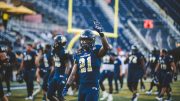Aubrey Carr/Staff Writer
The University of Missouri incidents involving blatant racism in the Fall of 2015 have initiated activism and protests across the nation, but have also put reporters in a position where they can be blocked. For professors, some feel their lectures and course content may be too triggering to be taught freely. “Safe Spaces” are compulsory, according to Dan Capote, President of the Stonewall Pride Alliance (SPA), who opposes the school of thought that Safe Spaces stifle ideas.
Capote says there are “four benefits” SPA provides: developing community, leadership qualities, diversity and activism. He likens the four hour long SPA meetings to “coming out of a war zone.” People must be relaxed and then you can start your work. “When you deal with ‘the closet,’ you deal with people [who aren’t] confident with self-expression,” Capote said.
Each attendee has the option to introduce him/herself and declare the pronouns s/he prefers, in addition to gender and sexual identity. Capote said the group “establish[es] bonding through self-disclosure” and “opens a dialogue for people whose pronouns may not be easily assumed.” SPA is a physical Safe Space and encourages discourse in the name of education when there are inquisitive but confused open minds, because, “By educating, you naturally create activists.” Capote told FIU Student Media.
Capote said safe spaces are especially useful for transgender persons who “endure misgendering out of safety,” or are “outed” and at risk for harassment if they announce their true identities.
In September 2015, President Barack Obama addressed the controversy hailed by “Safe Spaces” at an Iowa town hall meeting: “Some college campuses…don’t want to have a guest speaker who is too conservative or they don’t want to read a book if it has language that is offensive to African-Americans or somehow sends a demeaning signal towards women…I don’t agree with that,” he said.
Obama disagreed with the thought that “when you become students at colleges, [you] have to be coddled and protected from different points of view.” He believes colleges should invite guests of different outlooks and if there is conflict, “you should have an argument. But you shouldn’t silence them by saying, ‘You can’t come because I’m too sensitive to hear what you have to say.’ That’s not the way we learn either.”
There is a difference between a physical safe space and an intellectual one. The former is essential until there is full equality between every human being.
Targeted groups like the LBGTQA community, women, members of the black community and certain religious groups need a place where the individuals can be protected, lest their lives and livelihoods be endangered.
An intellectual safe space, however, is equivalent to disregarding important, albeit difficult, conversations that can help call for reform if we let them. If we do not academically engage in history like the Suffragettes, the Holocaust, the LBGTQA fight, or slavery and the Civil Rights Movement, we do not learn. We do not acknowledge humanity’s mistakes and learn how to combat similar situations in the future. These critical thinking skills are indispensable for social reform and universities have historically been hubs for progressive ideas to hatch and gain support.
Jonathan Chait, a political columnist for New York Magazine, separated the two safe spaces perfectly in an interview with NPR about political correctness on college campuses: “I’m in favor of safety. What I object to is defining safety to mean the absence of contrary points of view. And by contrary, I don’t mean hate speech, I don’t mean threats, I don’t mean swastikas. What I mean is the performance of a play that people dislike politically, the appearance of an op-ed that somewhat mildly criticizes views that you hold – those are things that people have defined as threatening a safe space.” Chait explained.
In the same interview with NPR, author Roxane Gay also commented that “there is very little to be gained from suffering. I think what students are looking for is a space where they don’t have to suffer emotionally. As a teacher, I try to create as safe a space as possible, but I also know that my job is to make students uncomfortable. So I think students aren’t asking to be coddled. They’re asked to be treated with respect and I don’t think there’s anything wrong with that.”
It is unfair to ask professors of gender or race studies to censor their lectures on inherently controversial topics. If it is too difficult a subject to endure, refrain from enrolling in the course. If it a mandated class, perhaps this can serve as a way to cope with a triggering situation.
Books like Uncle Tom’s Cabin or Mein Kampf, though plagued with heart-breaking injustice, are crucial to understanding history and how to better the future. We could even consider their relevance to the 2016 presidential election.
Do not harass your students, but do not shelter them. It is possible to have healthy discourse on a heavy subject, because discussing gender, racial, or sexual equality, nor the topic of abortion, rape, war, or the likes does not automatically grant the participants permission to assault or harass anyone. It is possible to bring up controversy without attacking a group or individual. These conversations must be had.
If a student must leave the room to collect himself, that’s okay. But we shouldn’t halt an entire dialogue because of an uncomfortable student. There are uncomfortable issues that require more than one outlook to solve and we must meet them with open arms and open minds – whilst keeping students emotionally and physically safe from explicit harassment directed at them – if we are to move forward.
DISCLAIMER:
The opinions presented within this page do not represent the views of FIU Student Media Editorial Board. These views are separate from editorials and reflect individual perspectives of contributing writers and/or members of the University community.
Image courtesy of Flickr: https://www.flickr.com/photos/jiscinfonet/2296206302/in/photolist-4uUE8Q-dYohe-kPyfEZ-6iBbYK-oxdH23-9NJhg3-oxe3zE-ejGRcF-4uUCXh-6Rxt11-5Cfos1-6w4ioL-dYB9b-7pdceV-7pddfx-7ph6iY-6wqn5e-9NKoA3-oxe2Vo-9NJdLE-gXwhbF-9NJfwE-9dsPvL-gXvh4F-9NFLN1-8eHgpD-exWDjP-oPHnHz-6w4iyE-v1rvF-7ph3zE-7zebtr-bstmZU-6UgKkW-4xn1kr-c2Ru7m-c2Rub3-oxdYzL-ee3ZyK-eXn9tg-r3rsd8-a1JSoT-CANC67-rnKLMe-rkA4Vj-qr6Uwp-qr6Tp4-r6jvbj-wmnuDT-5CgECh






Be the first to comment on "Safe Spaces: Physical and Intellectual"